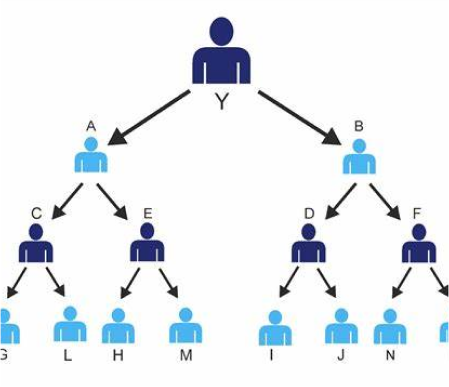
Binary MLM Software
Take a look at the different scenarios of forming a binary structure
Before you get into the structure, try to understand the difference between a sponsor and the parent of a downline.
Binary MLM Structure
Sponsor: the distributor who introduced the new member to the binary network.
Parent: The channel partner who is the direct upline of the new member introduced to the binary network
Scenario 1: The sponsor and the downline parent are the same
sponsor and downline parent
If distributor X is a sponsor of A and A introduces a new member B at the left position of A in the binary tree, then B is the direct downline of A. In turn, if A sponsors a new member C, then it is added to the right of A since it was the free position. Now B and C are the direct downlines of A and the binary tree of A is formed to receive the binary commission. A is both the sponsor and the parent of B and C.


Scenario 2: The sponsor and the parent of the downline are different
sponsor and parent of the downline
Here X sponsors A and Y, where Y is placed under the right leg of A, and now A sponsors the new member B, where B is placed under the left leg of A since there is no free position on the left leg of A. Here, the sponsor and the parent are different for downline Y. A's binary is formed from its own efforts and the efforts of the upline (X) through spillover from member Y.
Scenario 3: Spillover without complete formation of the binary
spillover-without-complete-formation-of-the-binary
Distributor X introduces or sponsors two new members A, X1 on the right, and the left leg of X's binary structure and binary is formed. Now A sponsors new member B on the right leg, as the left position of A is occupied by new member Y, who is in turn sponsored by X. X also sponsors Z and places it on the right of X1. Here, Y and Z are spillovers and are placed under X's downlines, i.e., A and X1. Y is placed under the left downline of X, i.e. A, and Z is placed under the right downline of X, i.e. X1. If you look at the image, it is clear that the two spillovers have occurred on two sides of X without forming a binary on either side.


Scenario 4: Sponsoring only on the left leg of the binary structure
sponsoring only on the left leg of the binary structure
In this scenario, A introduces two new members B and C. B is placed below the position of the direct left leg of A and C is placed next to the position of the direct left leg of B. Here, C is the spillover placed on the far left.
Scenario 5: Normal spillover in a binary structure
normal-spillover-in-binary-structure
When the left and right legs of a member are occupied, the next new member to be sponsored is placed as a spillover below the next level. This is referred to as normal spillover.
When trader X sponsors new members A and X1, X's binary structure is completed. If X in turn sponsors new members Y and Z, they are placed as normal spillovers under the next level.
Scenario 5: Normal spillover in a binary structure
Normal-spillover-in-binary-structure
When the left and right legs of a member are occupied, the next new member to be sponsored is placed as a spillover below the next level. This is referred to as normal spillover. When trader X sponsors new members A and X1, X's binary structure is completed. If X in turn sponsors new members Y and Z, they are placed as normal spillovers under the next level.





